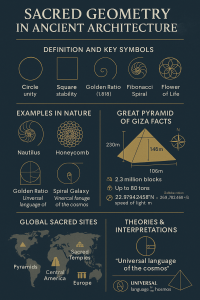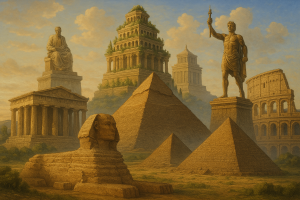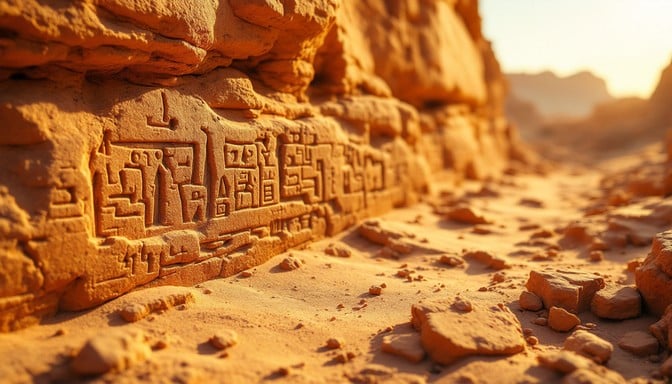Sacred Geometry: Did Ancient Architects Use a Hidden Code in Structures?
Have you ever stood before an ancient monument and felt a chill down your spine, as if the stone itself was whispering secrets of a long-lost civilization? From the towering pyramids of Egypt to the ornate cathedrals of Europe, humanity’s grandest structures seem to pulse with hidden meaning. Could it be that ancient builders encoded a powerful system into stone—a system that connects math, mystery, and the divine?
Welcome to the world of sacred geometry in ancient architecture—where shapes speak, numbers resonate, and mysteries unfold.
What Is Sacred Geometry?
Sacred geometry explores patterns and proportions believed to have spiritual and symbolic significance. These geometric principles are not just decorative—they echo in the natural world, appearing in everything from nautilus shells to galaxy spirals.
Key sacred symbols:
-
Circle: Unity, eternity
-
Square: Earthly order, foundation
-
Golden Ratio (~1.618): Harmony, beauty, balance
-
Fibonacci Sequence: The numerical rhythm of life, seen in sunflowers, pinecones, and DNA
Ancient sages and mystics believed these forms were the blueprint of the universe—used not just in art, but in temples, pyramids, and entire city layouts.
The Flower of Life, made of overlapping circles, has appeared in cultures from Egypt to India to medieval Europe. Why? Was it just artistic, or was it encoding cosmic knowledge?
Sacred Geometry in Ancient Architecture
Across the ancient world, some of humanity’s most iconic structures contain stunning geometrical precision. But were these sacred patterns deliberately encoded—or are we projecting modern meaning onto ancient stones?
Let’s investigate one of the most famous examples.

The Great Pyramid of Giza: Blueprint of the Cosmos?
The exact date of the Great Pyramid of Giza’s construction remains a topic of debate among scholars. Traditional Egyptology suggests that it was built around 4,500 to 5,000 years ago, during the reign of Pharaoh Khufu, around 2,560 BCE. However, geological evidence from the Giza Plateau hints at the possibility that the pyramid could be much older than commonly believed. Some researchers argue that signs of erosion on the plateau suggest the construction of the pyramid might date back to a time long before the traditional timeline, possibly stretching back 7,000 years or more. The engineering construction is not just an architectural feat—it’s an ancient enigma that continues to spark debate among historians, engineers, and mystery seekers.
Mind-Bending Mathematical Alignments:
-
Golden Ratio: The ratio of its slant height to half the base = ~1.618
-
Pi: Base perimeter divided by 2×height ≈ 3.145—almost exact to π
-
Speed of Light: Its latitude (29.9792458°N) matches the speed of light in m/s (299,792,458)
Geographic Precision:
-
Aligned to true north with only 3/60th of a degree of error
-
Sits at the geographic center of Earth’s landmass
-
Its perimeter equals half a minute of equatorial latitude, suggesting global measurements
Construction Mysteries:
-
Composed of over 2.3 million blocks, some weighing up to 80 tons
-
Built without wheels, pulleys, or iron tools
-
Foundation is leveled within half an inch—across 13 acres!
The Great Pyramid even functions as a sundial, marking solstices and equinoxes with its shadows. Coincidence? Or evidence of knowledge far beyond what mainstream history attributes to ancient Egypt?
What Did the Builders Know?
If sacred geometry was truly encoded into ancient architecture, it implies the builders:
-
Had deep understanding of geometry, astronomy, and Earth sciences
-
Measured the planet’s curvature with uncanny precision
-
Used advanced tools or techniques that modern experts can’t fully explain
Were they working with lost knowledge? Were they guided by cosmic principles—or something else entirely?
Science vs. Symbolism: Was It Intentional?
Skeptics argue that these alignments and ratios are either coincidental or the result of selective interpretation. They say ancient builders were engineers, not mystics.
But when similar geometric codes appear in ancient structures across Egypt, Mesopotamia, Mesoamerica, South America, and Asia, the coincidences start to feel… less accidental.
Could there be a universal design code embedded in the DNA of ancient civilizations?
Final Thoughts: Decoding the Past
For mystery lovers and history seekers, sacred geometry invites us to look deeper—to question not only how these structures were built, but why. Were ancient monuments merely tombs and temples? Or were they mathematical messages in stone, meant to connect heaven and Earth?
Whatever the truth, sacred geometry challenges us to consider the possibility that the ancients understood far more than we give them credit for—and left us a puzzle still waiting to be solved.






